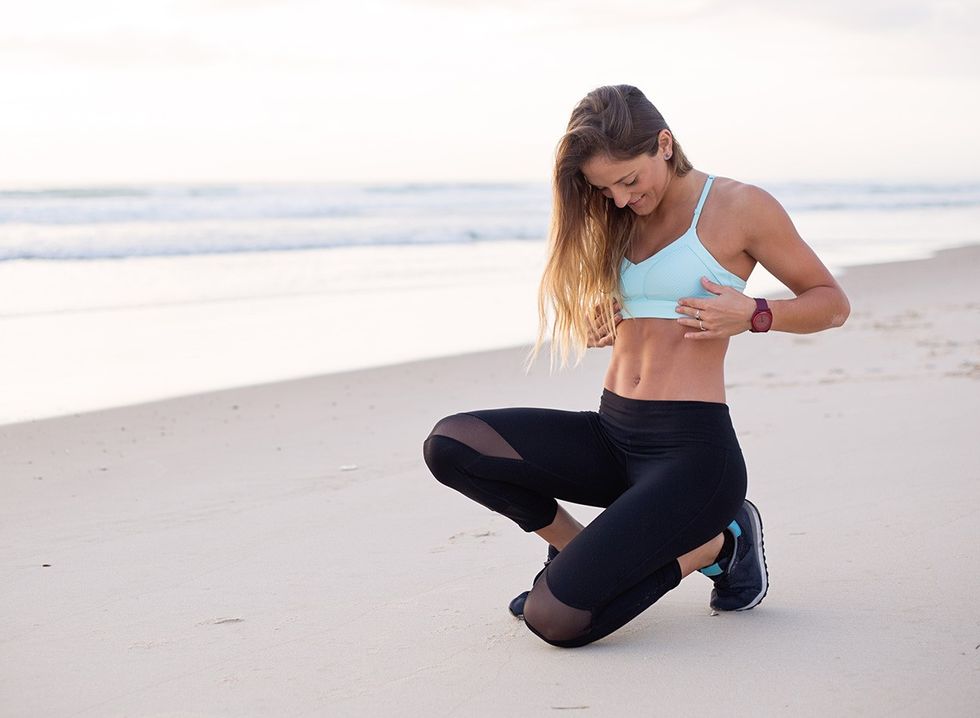Does your lower back feel stiff after sitting at your desk all day? Or maybe you're worried about injuring yourself during workouts? You're not alone. In fact, most people are doing their core exercises wrong – and it's putting their backs at risk.
Anna Atras, a Pilates and Mobility Coach, has spent years helping clients overcome back pain through proper core training. "Many people think the core is simply the six-pack abs, but that's incorrect," she explains. In this comprehensive guide, she shares her most effective moves for building a bulletproof back.
Ready to learn the right way to train your core and prevent back pain? Let's dive into Anna's proven 8-move system, from fundamental techniques to advanced variations.
Why Traditional Core Training Fails Your Back
"In scientific literature, we refer to the core as a three-dimensional space with muscular boundaries – essentially a muscular box," Anna explains in her post. She describes how this box comprises 29 pairs of muscles that work together to stabilize your pelvis and lower back during movement, including the diaphragm, pelvic floor, and abdominal wall muscles.
RELATED: She Has Instagram-Famous Abs and Here Is What She Eats in a Day to Achieve Them
The Hidden Connection Between Core and Back Pain
"Core stability is simply the ability to control the position of this region, abdominal and lower back region, and specifically of the lumbopelvic hip complex," Anna explains. This complex system creates what she calls "a corset-like stabilization effect around trunk and lower back spine and also pelvis," which is crucial for maintaining a neutral spine position.
Move 1: Master Your Breathing Foundation

Anna starts every client with proper breathing mechanics: "At the start of your core stability enhancement journey, you could start with diaphragmatic breathing, make sure the diaphragm is doing its job." She suggests practicing abdominal hollowing ("drawing navel towards the spine") and abdominal bracing, which she describes as "wrapping a belt around the belly or even using your hands and pressing into the abdomen."
RELATED: Lindsay Lohan Flaunts Washboard Abs: Here’s Her “Little Secret” to Looking Great at 38
Moves 2-4: The Essential Trio
For beginners, Anna recommends three key exercises:
- Knee Hovers: "Maintaining neutral spine and you see every time you lift, you exhale, you brace, you can see abdominals kicking in immediately."
- Modified Side Plank: "Create a straight line from the tailbone through the spine to the crown of head, holding for 10 seconds."
- Supine Bridge: "Drive your pubis up or your pelvis up tucking tailbone under... don't flare your ribs to the ceiling."
Move 5: The Bird Dog Progression
"It's all about creating stiffness through the midsection, creating stability around the lumbar spine," Anna explains when describing the bird dog exercise. She emphasizes proper form: "Don't lift the arm or leg too high and try to maintain that neutral position of the back. Don't hyperextend, don't let the pelvis rotate."
Move 6: The Marching Bridge
As you build strength, Anna introduces movement: "Try marching on the spot. From the bridge, you simply brace, prepare, keeping your hips square to ceiling." She emphasizes the importance of control: "You want to keep the trunk, the rib cage position of the lower back exactly the same as if both feet were on the ground."
Move 7: The Plank Slider Challenge]
For those ready for more challenge, Anna introduces her favorite advanced movement: "The plank slider is probably one of my favorite and most challenging core exercises." She describes how this variation requires "good shoulder stability" while challenging all the core muscles discussed earlier.
RELATED: Woman Lost 25 Pounds on Mounjaro Without Exercise and Shares 8 Key Tips
Move 8: The Ultimate Back Protector
Anna saves her signature movement for last: "The bird dog on steroids, as I call it, performed on the forearms and knees down." She explains that at this level, "you will feel with every change of position how the trunk and core musculature adjust to protect the lower back to keep it stable."
According to Anna, proper core function is essential for spine health: "Without these abdominal muscles working properly and doing their job, the spine would become mechanically unstable." She emphasizes how this affects everyday activities: "Think of weightlifting, deadlifts, squats, picking up the kids, and also gravity. You want these muscles to work to create mechanically stable position."
💪🔥Body Booster: Focus on mastering each move before progressing to the next. Your back will thank you for taking the time to build proper core stability from the ground up. And if you enjoyed this article, don't miss 12-3-30 Walking Method: 20 Proven Tips to Lose Weight Faster.














 Shutterstock
Shutterstock Shutterstock
Shutterstock

 Shutterstock
Shutterstock Shutterstock
Shutterstock Shutterstock
Shutterstock Shutterstock
Shutterstock Shutterstock
Shutterstock Shutterstock
Shutterstock Shutterstock
Shutterstock Shutterstock
Shutterstock Shutterstock
Shutterstock Shutterstock
Shutterstock Shutterstock
Shutterstock Shutterstock
Shutterstock Shutterstock
Shutterstock Shutterstock
Shutterstock Shutterstock
Shutterstock

 Shutterstock/fizkes
Shutterstock/fizkes Shutterstock
Shutterstock Shutterstock
Shutterstock Shutterstock
Shutterstock Shutterstock
Shutterstock Shutterstock
Shutterstock
 Shutterstock
Shutterstock Shutterstock
Shutterstock Shutterstock
Shutterstock Shutterstock
Shutterstock Shutterstock
Shutterstock Shutterstock
Shutterstock Shutterstock
Shutterstock Shutterstock
Shutterstock Shutterstock
Shutterstock

 I'm a Nutritionist and These 9 High-Protein Snacks Keep My Clients Full While Losing 50 Pounds
I'm a Nutritionist and These 9 High-Protein Snacks Keep My Clients Full While Losing 50 Pounds
 Shutterstock
Shutterstock 2. Processed FoodsShutterstock
2. Processed FoodsShutterstock Shutterstock
Shutterstock Shutterstock/Prostock-studio
Shutterstock/Prostock-studio Shutterstock
Shutterstock Pro TipsShutterstock
Pro TipsShutterstock Shutterstock
Shutterstock Shutterstock
Shutterstock Shutterstock
Shutterstock Shutterstock
Shutterstock Don’t Drink as Much AlcoholShutterstock
Don’t Drink as Much AlcoholShutterstock Most Women on GLP-1s Are Making a Few Common MistakesShutterstock
Most Women on GLP-1s Are Making a Few Common MistakesShutterstock Soda and Sugary DrinksShutterstock
Soda and Sugary DrinksShutterstock Shutterstock
Shutterstock Eat BreakfastShutterstock
Eat BreakfastShutterstock And Improve Insulin SensitivityShutterstock
And Improve Insulin SensitivityShutterstock Belly Flab Strip Tip: Sugar and Fat Calories Leave Its Mark on Your BodyShutterstock
Belly Flab Strip Tip: Sugar and Fat Calories Leave Its Mark on Your BodyShutterstock Shutterstock
Shutterstock The Drugs Mimic the GLP-1 Hormone Naturally Produced by the BodyShutterstock
The Drugs Mimic the GLP-1 Hormone Naturally Produced by the BodyShutterstock 3. Deep-Fried ItemsShutterstock
3. Deep-Fried ItemsShutterstock